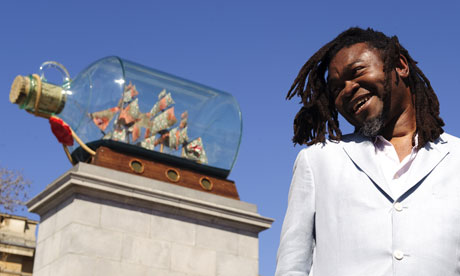Segregating artists in the name of 'diversity' does them a disservice – as the complex multicultural narrative behind Yinka Shonibare's fourth plinth artwork demonstrates.
Article written by Munira Mirza published on guardian.co.uk on Tuesday 25 May 2010.
 |
| Sailing past the colour bar ... Yinka Shonibare with his work for the fourth plinth, Nelson's Ship In a Bottle. Photograph: Jonathan Hordle/Rex Features |
Tonight I will be appearing on a panel at Tate Britain discussing multiculturalism in the arts, inspired by the latest fourth plinth commission in Trafalgar Square, Yinka Shonibare's Nelson's Ship In a Bottle. This remarkable artwork reproduces Horatio Nelon's ship, HMS Victory, but with a colourful twist: the sails are made of African batik fabrics, one of Shonibare's signature touches.
Even here there's another twist. As Shonibare has pointed out, the fabrics aren't straightforwardly African: the material is Dutch waxcloth, originally based on Indonesian methods of wax-printing, then exported to Africa in the mid-1800s and slowly established as the cloth of choice for African clothing. Shonibare buys the fabric (which is now largely produced in Manchester and Helmond, in the Netherlands) at Brixton market, a place symbolic of London's position in the global exchange of cultures, ideas and products. Calling himself a "post-colonial hybrid", Shonibare celebrates this element of crossbreeding: "It's the way I view culture – it's an artificial construct," he said in an interview with ArtNews in 2002.
Shonibare's works are a powerful reminder that cultures are almost never "pure", but rather made from a messy entanglement of influences. Delft pottery in Holland, which dominated the European porcelain industry in the 17th century, arose out of trade with Japan, whose oriental designs influenced early designs. Many kilt tartans you see today were designed by English tailors under the rule of Queen Victoria, rather than by Scottish highlanders. Even some of the great thinkers and writers of the western canon were "imported": the Roman playwright, Terence, one of the founding fathers of western drama, was a freed slave from Carthage. St Augustine, philosopher and seminal figure of medieval Christianity, was from modern-day Algeria.
Diversity enables this kind of cultural mixing to take place, for people to hear new ideas and acquire the best of what they see, eat, enjoy and learn. London (along with other international cities such as New York, Singapore, and Berlin) has become a place for people around the world to live, visit, consume and make culture – and, of course, do business. And while we are inevitably drawn to the culture of our upbringing, the migrant experience shows we can also be inspired by new places. Derek Walcott, Caribbean poet and Nobel laureate, famously said: "Something prickles in me when I see the word 'Ashanti', as with the word 'Warwickshire'."
But here's the rub: diversity, when the word is used to describe arts policy, seems to be a different thing altogether. Indeed, by trying to capture the essence of difference, it seems to snuff it out altogether. In this reading, culture is not fluid, but defined in rigid categories. Artists are not artists but black, Asian or minority ethnic – "culturally diverse". There are special publicly-funded bursary schemes for black artists, and targets for funding black-led arts groups. There is even a new MA course at a major art school exclusively for black and minority-ethnic art curators.
Yet what does "black art" mean, if blackness itself is a mixture of cultural influences? If black artists can win major commissions and international acclaim, why do we assume that to be black is always to be marginal, or in need of special support? We have to recognise how diversity initiatives can make black artists feel ghettoised and, as some cultural commentators have argued, bear "the burden of representation". Of course, being culturally different in the past was also to suffer prejudice, but much has changed in the past two decades, and old racist attitudes have declined significantly. Barriers today are largely class-based – income, networks, education. And those affect many white people as well.
The past 20 years, particularly in London, have seen a phenomenal change in the way cultures in Britain live together. Nelson's Ship In a Bottle marks the moment to recognise this shift, and ask again what it means to be part of an ethnic minority in Britain today. We may well be surprised by the answers.
Read reactions to this article at:
Read reactions to this article at:

No comments:
Post a Comment